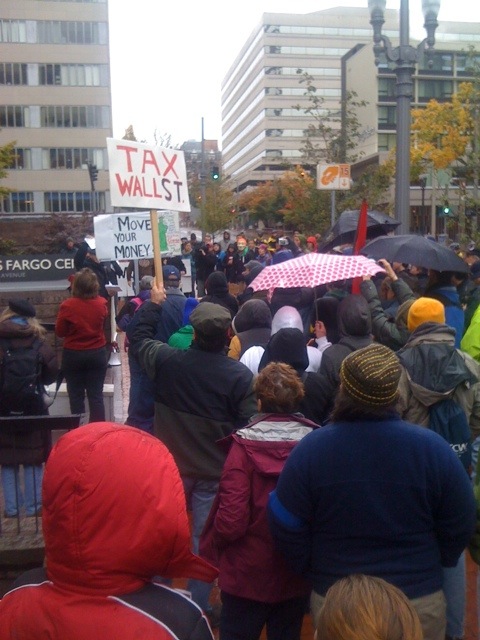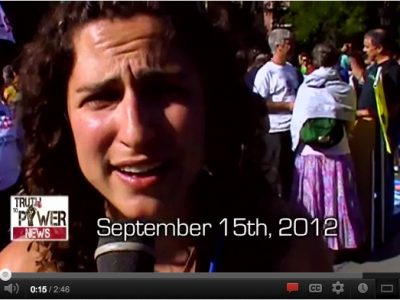by Chiara T. Ricciardone
The Occupy movement is a virus. That is obvious. But the metaphor veers disturbingly into the real—exhibiting the virus’ trademark capacity for metalepsis and contagion—when we think of the lurid stories that broke out in November: “Zucotti lung” at OWS, the deadly canine parvovirus over the bridge at OccupySF. The evictions that followed, in turn, are consonant with what we have known for some time now about the authoritarian political project of public health.
Equally obvious, however, is that the corporate financial system targeted by Occupy is parasitic too: it is parasitic on the people whose house mortgages it sold and traded, parasitic on the citizens whose tax-revenue it has consumed, parasitic, ultimately, on the finite reserves of the environment.
And then, there are those pests accused of parasitizing Occupy. Ninety-nine percent of us reviled the attempted appropriations by every leftist outfit with an email list. But more controversially, every local Occupy has struggled with the disruptions and divisions within the camps. Do the “ghettos” that invariably develop in the parks and plazas merely leech off of the functioning Occupy organism? Can and should the spokescouncil style of organization developed by #OWS immunize the movement from such disruptions? And finally, uncomfortably, there is us: artists, scholars, students, writers, rushing to produce and present, to disseminate our pet ideas through the vitality of Occupy.
There is, it turns out, such a thing as a virus of a virus.
Who then is the virus, and who is host? What can the figure of the virus—in its reflexivity, itself so symptomatic of our age, spreading like mad—tell us about Occupy?
First, by way of a definition. The biological virus is known as an obligate parasite, meaning that it can’t reproduce outside of a host cell (though unlike the parasite, it is a non-cellular being, and thus usually not considered alive). In this loveliest of books, Michael Serres thinks the broader category of the parasite as the basic structure of human relationships. The parasite, which also means “static” in French, introduces disruption in the system (it is what others have called the clinamen). Serres notices immediately the chain of virulence that we observed plaguing Occupy: everywhere he looks, he shows the parasite of the host itself being parasitized. And as the parasite burrows into the fleshy feast that is its host, it appropriates the property for itself with its dirt and disorder: it takes space, takes power with a noise (the drum circle!) or smell (burning sage) or more elementary stercoral means. (Serres expands on this insight in his more recent Malfeasance: Appropriation through Pollution (trans. 2010).
The chain-linked structure of parasitism means that the disorder introduced by the bug can quickly become the New Order. As people invariably remark, the word “virus” comes from a Latin word that can mean both the venom of a snake and the semen of a man: like the pharmakon, the virus both destroys and creates. This is true. But we might also summon a different image. Biologists know that an endogenous retrovirus, a once-dangerous virus that has been integrated into the genome of the host, is crucial to human and other mammalian conception. Specifically, this domesticated virus produces a protein that allows the placenta to connect to neighboring cells, so that nutrients can be transferred from the mother to the fetus. Viruses in general are known as the mix-masters of evolution—the God factor, if you will. But if Occupy is this kind of virus, it will not just re-arrange the world’s memetic furniture. It will conceive, link, and nourish a new one.
But the endogenous retrovirus, after all, projects a long way into the future. Who knows how many centuries of evolution were required to transmute that venom? We might not have much time; we need a virus that cures, fast. During the first world war, the Canadian physician Felix d’Herelle discovered a virus that lives on, and kills, bacteria: the bacteriophage. He went on to use this little virus to successfully treat dysentery, cholera, and even the bubonic plague. Can we imagine Occupy devouring the pestilence of capitalism, the black pustules of exploitation vanishing, strands of horizontality multiplying with hungry cosmopolitanism?
Much, therefore, depends on what kind of virus Occupy is, or becomes. Will the Nigerian strain mutate in a different direction than the North American? Will Occupy Chicago this May provoke a different immune system response than #OWS and Occupy Oakland did in the fall?
In a very long-term view, the countless viral and parasitic appropriations of Occupy, even down to Obama’s populist rhetoric in the latest state of the union address, may not be what we ought to worry about. We are, already, reformulating the world’s political DNA. Instead, the figure of the virus re-frames essential tactical questions with sharp urgency. How do hosts neutralize their unwanted guests? What exactly is Occupy’s host—the local cities, the national body politic?—and do we want to kill it? And if we do, are we prepared to inhabit a new host? As virus, we are reminded of our vulnerability: our basic dependence on what we seek to overcome.
Conversely, Serres reminds us of our motto and our strength: “Metamorphosis is omnipotence.” In a placard-sized word: Mutate!







